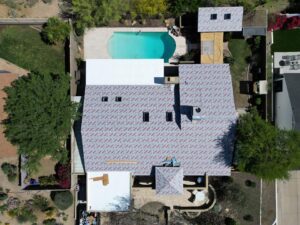Shield Beneath the Shingles: How Underlayment Choices Prevent Thermal Cracking in Hot Climates

The Hidden Hero of Your Roof
One of the biggest threats to your roof’s longevity in these areas is roof thermal cracking. Caused by rapid daily temperature swings, thermal cracking can significantly reduce the life of your roof. Choosing the right underlayment is the key to defending against this silent saboteur.When most homeowners think about their roof, shingles, tiles, or foam come to mind. But what lies underneath those materials is what truly protects your home from harsh weather: the underlayment. This essential layer forms the first line of defense against extreme temperatures, especially in hot-climate states like Arizona, New Mexico, Utah, and Florida.
What Is Thermal Cracking and Why It Happens
Understanding Thermal Expansion and Contraction
Roofs endure a daily battle with nature. During the day, roofing materials absorb heat, expanding as temperatures rise. When the sun sets, they rapidly cool and contract. This cycle—known as thermal expansion and contraction—occurs every single day, particularly in arid and semi-arid climates.
The Damage It Causes
Over time, this repetitive movement leads to cracking, buckling, and granule loss. Shingles can become brittle, tiles may crack, and seams in the roofing system may begin to separate.
Underlayment: The Flexible Buffer
The right underlayment serves as a flexible cushion that absorbs these stresses. It prevents surface materials from directly bearing the brunt of expansion and contraction, significantly reducing the risk of roof thermal cracking.
Types of Underlayment—and Why It Matters
1. Asphalt-Saturated Felt
This traditional choice is made from organic or fiberglass base materials saturated with asphalt. It’s cost-effective, but less resilient in high temperatures. Over time, it can dry out and lose flexibility, making it vulnerable in hot climates.
2. Synthetic Underlayment
Made from durable polymers, synthetic underlayment is lightweight, tear-resistant, and heat-tolerant. It doesn’t absorb moisture and resists mold growth, making it an ideal choice for modern roofs exposed to intense sun.
3. Self-Adhered (Peel-and-Stick)
This advanced underlayment offers superior sealing power, adhering directly to the roof deck. It acts as a vapor barrier and seals around nails and fasteners, reducing water infiltration. It’s especially recommended for homes in high-temperature zones due to its heat and moisture resistance.
Why Underlayment Choice Is Critical in Southwest and Sunbelt States
Region-Specific Thermal Challenges
- Arizona, New Mexico, Utah – These areas often experience 40°F or more in temperature fluctuations within a single day. Combined with high UV exposure, this creates a recipe for rapid material degradation.
- Florida – The combination of heat and humidity makes underlayment choices crucial. Without proper vapor barriers, moisture can become trapped, leading to mold growth and roof rot.
Our Recommendation: Premium Synthetic or Self-Adhered Underlayment
Reimagine Roofing consistently recommends high-performance underlayment options for homes in these regions. Our go-to solutions are either premium-grade synthetic underlayment for most pitched roofs or self-adhered membranes for added protection in storm-prone or extremely hot areas.
Real-World Results from Reimagine Roofing Jobs
Phoenix, AZ – Heatproofing Success
One of our clients in Phoenix was dealing with recurring cracking after every summer. After upgrading to a self-adhered underlayment system, they experienced zero thermal cracking even during the hottest season on record.
Florida Commercial Project – Reinforced Foam Roofing
A commercial facility in Orlando opted for a reinforced underlayment beneath their flat foam roofing system. This layer absorbed heat stress while offering superior waterproofing, preventing both cracking and internal moisture damage.
When and How to Inspect or Upgrade Your Underlayment
Common Warning Signs
- Buckling or rippling on the roof surface
- Unexplained leaks or water stains on ceilings
- Visible seams or exposed areas beneath shingles
Seasonal Timing: Summer Is Prime Time
Spring and early summer are ideal times for inspections—before monsoon rains or hurricane season hit. Our free roof inspections can detect early signs of underlayment failure and recommend timely upgrades to protect your home.
Don’t Let the Heat Crack Your Investment
The visible parts of your roof may seem like the star of the show, but the underlayment is the unsung hero. Its role in preventing roof thermal cracking cannot be overstated. Your entire roofing system’s effectiveness hinges on this hidden layer’s ability to withstand heat, moisture, and movement.
Reimagine Roofing brings expert eyes and proven solutions tailored to your local climate, roof slope, and building structure.
Ready to protect your roof from thermal damage? Book your FREE roof inspection with Reimagine Roofing today. Our experts will assess your underlayment and recommend the best heat-ready solution for your home.
👉 Schedule Your Free Roof Inspection Now
👉Use our Fast Quote Tool, Estimates in Less Than 24 Hrs
FAQs
Q1: What is roof thermal cracking and how does underlayment help prevent it? A: Roof thermal cracking occurs due to temperature-induced expansion and contraction. Underlayment acts as a cushion that absorbs stress, preventing damage to outer roofing materials.
Q2: What underlayment is best for hot climates? A: Synthetic and self-adhered underlayments are best for hot climates due to their heat resistance, flexibility, and moisture barrier properties.
Q3: Can I upgrade my underlayment without replacing the entire roof? A: In some cases, yes—especially if damage is localized. However, it’s often more cost-effective and longer-lasting to upgrade the underlayment during a full roof replacement.
Q4: How often should underlayment be inspected? A: Ideally once a year or before major seasonal weather events, such as summer storms or winter snow.
Q5: How do I know if my current underlayment is failing? A: Look for signs like interior leaks, warped shingles, visible seams, or rising energy bills. Reimagine Roofing offers free inspections to determine the condition of your underlayment.

